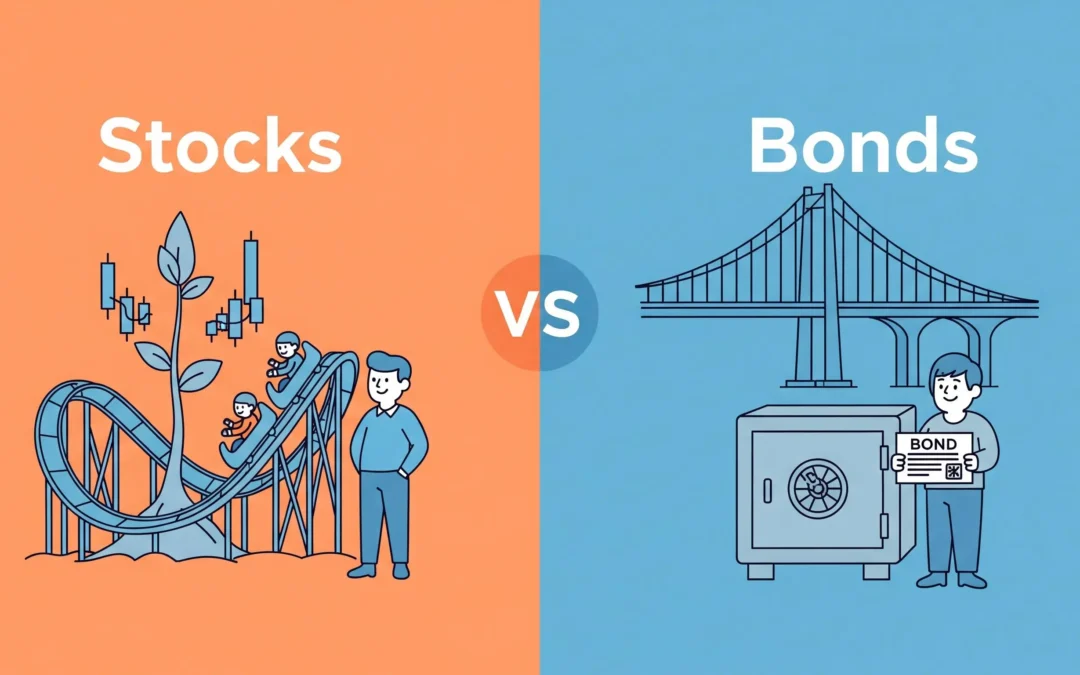One of the most effective strategies to gradually increase your wealth is through investing. Making wise investment decisions can make all the difference, whether you’re saving for a major purchase, retirement, or just want to make your money work harder. Stocks and bonds are two of the most popular investment options, but it’s not always easy to decide between them.
In the world of finance, stocks and bonds are both essential, but they have quite different functions and appeal to different kinds of investors. Ownership in a company is represented by stocks, which carry a higher risk but also the possibility of large returns. Conversely, bonds are debt instruments that usually have lower returns but offer more stability and predictable income.
Let us understand the difference between both and which one will suit you the best.
What Are Stocks?
Equities, sometimes referred to as stocks, are a portion of a company’s ownership. Purchasing stock effectively makes you a shareholder, or a portion owner, of that business. You are entitled to a share of the business’s profits as a result of this ownership, usually in the form of dividends, as well as the chance to profit from future stock price increases. Also, stocks are generally liquid assets, meaning you can usually buy or sell them easily on the stock market.
For example, if you purchase ten Tata Motors shares at a price of ₹600 each, you will have invested ₹6,000. Your investment grows to ₹7,500 if the share price rises to ₹750, representing a ₹1,500 gain. If the business declares dividends, you might also receive them.
What Are Bonds?
Bonds are fixed-income financial instruments that symbolise a loan from an investor to a borrower, usually a corporation, government, or municipality. By purchasing a bond, you are lending the issuer money in return for periodic interest payments (known as coupons) and the principal amount (known as face value) being returned on a predetermined maturity date.
Bonds turn you into a creditor rather than an owner, in contrast to stocks, which grant you ownership in a business.
For instance, if you invest ₹10,000 in a five-year government bond with a 6% annual interest rate, you will earn ₹600 in interest each year for five years. Unless the issuer defaults, which is very rare with government bonds, you will receive your ₹10,000 principal back at the end of five years.
Difference Between Stocks and Bonds
| Aspect | Stocks | Bonds |
| Definition | Ownership in a company | Loan to a company or government |
| Investor Role | Shareholder (partial owner) | Creditor (lender to the issuer) |
| Returns | Dividends and Capital Gains | Fixed Interest (Coupon) and return of Principal |
| Risk Level | Higher (market volatility) | Lower (more stable, especially government bonds) |
| Term | No fixed maturity, typically held long-term, but liquid | Fixed maturity period |
Risk vs Return: Which One Fits Your Profile?
Understanding the long-term dynamics of returns, risk, and volatility is essential when selecting investment options. Although stocks have historically offered average returns of around 10–12%, they also carry the highest risk and volatility. Stocks are better suited for investors with a long-term horizon and a high-risk tolerance because they can fluctuate significantly in response to market conditions, company performance, or economic events.
Conversely, corporate bonds provide moderate risk and volatility along with typically offering returns around 4-6%, with high-yield options potentially reaching 6-8% but with increased risk. For investors who prefer higher returns than government bonds but are uncomfortable with stock volatility, these are perfect.
Last but not least, government bonds offer the safest and most reliable returns, averaging 2–4% annually in today’s environment, though historically closer to 3–5% with minimal risk and volatility. They are ideal for cautious investors who want to protect their money and generate a consistent income free from market fluctuations.
In conclusion, every investment type has a unique risk-reward trade-off, and your time horizon, financial comfort level, and investment goals will all influence which combination is best for you.
| Investment Type | Average Annual Return (Long-Term) | Risk Level | Volatility |
| Stocks | 10–12% | High | High |
| Corporate Bonds | 6–8% | Moderate | Moderate |
| Govt. Bonds | 2–5% | Low | Low |
As attractive as the returns may look for the stocks, the risk involved is comparatively high. Bonds offer safe returns and are dependable, and therefore are best for conservative investors.
Example of a portfolio
The table below shows an assumed example for different investment profiles. Investors are advised to understand their risk-reward and diversify their investments accordingly.
| Investor Profile | Preferred Investment | Allocation Suggestion |
| Young & Aggressive | Stocks | 80% Stocks / 20% Bonds |
| Mid-Career & Balanced | Mix | 60% Stocks / 40% Bonds |
| Retired & Conservative | Bonds | 30% Stocks / 70% Bonds |
Bottomline
The bottom line can be drawn that people can more easily determine which investment best suits their financial objectives, risk tolerance, and investment horizon after learning about the main distinctions between stocks and bonds. Each option has advantages of its own advantages. Bonds offer security and steady income, while stocks offer high growth and return potential.
You should think about creating a well-rounded portfolio that is suited to your individual requirements in order to make an informed choice. For instance, a retiree may favour bonds for steady income and capital preservation, whereas a young investor with a long-term objective may be more inclined towards stocks for capital growth.
Risk Disclosure:
Investing carries risks, including the possibility of losing principal. Past performance does not guarantee future results. Before making investment decisions, assess your financial goals and risk tolerance, and consult a qualified financial advisor.
Written by: Tanya Kumari


